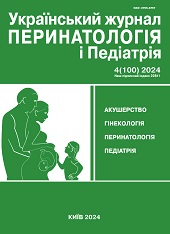Endocrine-immune factors in patients of reproductive age with hyperproliferative diseases of the uterus against the background of the threat of early abortion
DOI:
https://doi.org/10.15574/PP.2024.4(100).5155Keywords:
pregnancy, hyperproliferative diseases of the uterus, leiomyoma, adenomyosis, endocrine-immune factors, threat of early abortionAbstract
The main causes of adverse perinatal outcomes are miscarriage, placental dysfunction, gestosis, which are caused by hyperproliferative diseases of the uterus (HPD), past inflammatory diseases of the internal genital organs (IDIGO) and stress.
Aim - to study endocrine-immune factors in pregnant women with HPD and the threat of abortion in the first trimester of pregnancy.
Materials and methods. 64 pregnant women of reproductive age with HPD (uterine leiomyoma and adenomyosis) against the background of the threat of early abortion and past IDIGO before pregnancy (main group) were examined. The control group consisted of 30 pregnant women without HPD and no history of IDIGO. The cytokine profile was studied in the blood serum of pregnant women - TNFα, IFNγ, IL-8, IL-6, IL-4, the content of progesterone, prolactin and cortisol.
Results. In the first trimester of pregnancy, the average progesterone level in the main group was 13% lower than in the control group, which indicated a pronounced insufficiency of the function of the corpus luteum of pregnancy. An increase in cortisol and prolactin levels was also found, almost twice as high as in the control group (p<0.05). The TNFα/IL-4 ratio was almost 3 times higher than in the control group, and the IFNγ/IL-4 ratio was almost 2 times higher. IL-8 was increased in the main group almost twice as high, and IL-6 by 25.5% (p<0.05).
Conclusions. An increase in proinflammatory cytokines in pregnant women with HPD against the background of the threat of early abortion may indicate a shift in the cytokine profile in this pathology of pregnancy towards the inflammatory type and indicates a long course of IDIGO before pregnancy. Increased cortisol and prolactin may indicate a strain on the stress-realizing link of adaptive reactions in the conditions of martial law in Ukraine and may contribute to the threat of early abortion.
The study was performed in accordance with the principles of the Declaration of Helsinki. The study protocol was approved by the Local Ethics Committee of the institution mentioned in the work. Informed consent of the patients was obtained for the research.
The authors declare that there is no conflict of interest.
References
ACOG. (2019). Fetal Growth Restriction. American College of Obstetricans and Gynecologists Committee on Practice Bulletins - Obstetrics and the Society for Maternal-Fetal Medicin. ACOG Practice Bulletin No.204. Obstet. Gynecol. 133(2): e97-e109. https://doi.org/10.1097/AOG.0000000000003070; PMid:30681542
Albonici L, Benvenuto M, Focaccetti C, Cifaldi L, Miele MT, Limana F et al. (2020, Nov 18). PlGF Immunological Impact during Pregnancy. Int J Mol Sci. 21(22): 8714. https://doi.org/10.3390/ijms21228714; PMid:33218096 PMCid:PMC7698813
Ancheva IA. (2017). Psychoprevention of stress during pregnancy and childbirth. Health Woman. 5(121): 32-41. https://doi.org/10.15574/HW.2017.121.32
Hedström J, Herder T. (2023, Dec 31). Woman's sexual and reproductive health in war and conflict: are we seeing the full picture? Health Action. 16(1): 2188689. https://doi.org/10.1080/16549716.2023.2188689; PMid:36927249 PMCid:PMC10026773
Kaminskyi AV, Kharun IL. (2023). Obgruntuvannia vzaiemozv'iazku ta «efektu zamknenoho tsyklu» mizh posttravmvtychnym stresovym rozladom ta zvychnym nevynoshuvanniam vahitnosti. Reproductive health of woman. 3(66): 18-23. https://doi.org/10.30841/2708-8731.3.2023.283319
Li D, Zheng L, Zhao D, Xu Y, Wang Y. (2021). The role of immune Cells in recurrent Spontaneous Abortion. Reprod Sci. 28(12): 3303-3015. https://doi.org/10.1007/s43032-021-00599-y; PMid:34101149 PMCid:PMC8186021
Magee LA, Von Dadelszen P, Stones W, Mathai M. (2016). The FIGO Textbook of Pregnancy Hypertension. London: The Global Library of WoMedicine,s Welfare of Women Global Health Programme: 434. URL: https://www.glowm.com/resource-type/resource/textbook/title/the-figo-textbook-of-pregnancy-hypertension/resource-doc/2768.
Mannini L, Sorbi F, Noci I. (2017). New adverse obstetrics outcomes associated with endometriosis: a retrospective cohort study. Arch Gynecol Obstet. 295(1): 141-151. https://doi.org/10.1007/s00404-016-4222-7; PMid:27770245
Morelli S, Mandal M, Goldsmith Lt, Kashani BN, Ponzio NM. (2015). The maternal immune system during pregnancy and its influence on fetal development. Res Rep Biol. 6: 171-189. https://doi.org/10.2147/RRB.S80652
Pérez-Roncero GR, López-Baena MT, Ornat L, Cuerva MJ, Garcia-Casarrubios P et al. (2020, Sep). Uterine fibroids and preterm birth risk: A systematic review and meta-analysis. J Obstet Gynaecol Res. 46(9): 1711-1727. Epub 2020 Jul 6. https://doi.org/10.1111/jog.14343; PMid:32633025
Sarkodie EK, Zhou S, Baidoo SA. (2019). Influences of stress hormones on microbial infections. Microbial Pathogenesis. 131: 270-276. https://doi.org/10.1016/j.micpath.2019.04.013; PMid:30981718
Tsymbaliuk VI. (2020). Obstetrics and Gynecology help to save women's reproductive health in armed conflicts (monohrafiia). Lviv: 71-81.
Wang W, Sung N, Gilman-Sach A, Kwak-Kim J, Helper T. (2020). (Th) Cell Profiles in Pregnancy and Recurrent Pregnancy Losses: Th1/Th2/Th9/Th17/Th22/ThCells. Front Immunol. 11: 2025. https://doi.org/10.3389/fimmu.2020.02025; PMid:32973809 PMCid:PMC7461801
Zaporozhan VM ta insh. (2014). Akusherstvo. T. 1. Akusherstvo ta hinekolohiia. Natsionalnyi pidruchnyk u 4 t. Za red. akad. NAMN Ukrainy, prof. V.M. Zaporozhana K.: VSV «Medytsyna»: 928.
Zaporozhan VM ta insh. (2014). Neoperatyvna hinekolohiia. T. 3. Akusherstvo ta hinekolohiia. Natsionalnyi pidruchnyk u 4 t. Za red. akad. NAMN Ukrainy, prof. V.M. Zaporozhana K.: VSV «Medytsyna»: 928.
Downloads
Published
Issue
Section
License
Copyright (c) 2024 Ukrainian Journal of Perinatology and Pediatrics

This work is licensed under a Creative Commons Attribution-NonCommercial 4.0 International License.
The policy of the Journal “Ukrainian Journal of Perinatology and Pediatrics” is compatible with the vast majority of funders' of open access and self-archiving policies. The journal provides immediate open access route being convinced that everyone – not only scientists - can benefit from research results, and publishes articles exclusively under open access distribution, with a Creative Commons Attribution-Noncommercial 4.0 international license(СС BY-NC).
Authors transfer the copyright to the Journal “MODERN PEDIATRICS. UKRAINE” when the manuscript is accepted for publication. Authors declare that this manuscript has not been published nor is under simultaneous consideration for publication elsewhere. After publication, the articles become freely available on-line to the public.
Readers have the right to use, distribute, and reproduce articles in any medium, provided the articles and the journal are properly cited.
The use of published materials for commercial purposes is strongly prohibited.

